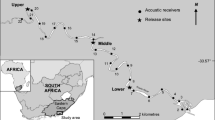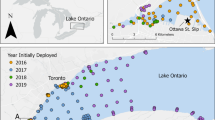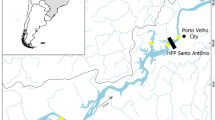Abstract
We investigated the post-passage movement patterns of three freshwater fish species, Carassius auratus, Hemibarbus longirostris, and Silurus asotus, frequently captured in a fishway trap as they were released into the lentic dam reservoir. Acoustic telemetry was used to monitor fish movement. Acoustic tags were attached to 10 individuals (C. auratus, [n = 6], Ca1–6; H. longirostris, [n = 2], Hl1 and Hl2; and S. asotus, [n = 2], Sa1 and Sa2). The individual (Sa1) was particularly monitored to changes of vertical distribution between day and night a depth transmitter. The lentic species, C. auratus and S. asotus, were grouped into those that moved into upper streams (Ca1, Ca2, Ca3, and Sa1) and those that stayed in the reservoir (Ca4, Ca5, Ca6, and Sa2); all individuals utilized almost the entire area of the reservoir. However, H. longirostris, which favor lotic environments, showed different responses; one (Hl1) immediately moved into one of upper the streams, whereas the other (Hl2) utilized the entire dam reservoir area. No significant correlations were observed between size of the C. auratus individuals (total length and total weight) and monitored parameters (total movement distance, movement distance per day, and number of receivers encountered). Moreover, S. asotus used the water at a mean depth of 2.89 ± 1.52 m, and its vertical distribution changed more actively during the night than that during the day. Therefore, the efficacy of the Jangheung Dam fishway could be improved through release of the confluence of the inflow streams at the dam reservoir, which would provide both lentic and lotic environments without extended migration for fish.




Similar content being viewed by others
References
Almeida D, Almodovar A, Nicola GG, Elvira B, Grossman GD (2012) Trophic plasticity of invasive juvenile largemouth bass Micropterus salmoides in Iberian streams. Fish Res 113:153–158
Antonio RR, Agostinho AA, Pelicice FM, Bailly D, Okada EK, Dias JHP (2007) Blockage of migration routes by dam construction: can migratory fish find alternative routes? Neotrop Ichthyol 5:177–184
Baxter RM (1977) Environmental effects of dams and impoundments. Annu Rev Ecol Syst 8:255–283
Godinho AL, Kynard B (2008) Migratory fishes of Brazil: life history and fish passage needs. River Res Appl 25:702–712
Grossman GD, Freeman MC (1987) Microhabitat use in a stream fish assemblage. J Zool 212:151–176
Habit E, Belk MC, Parra O (2007) Response of the riverine fish community to the construction and operation of a diversion hydropower plant in central Chile. Aquat Conserv 17:37–49
Harris JH (1984) Impoundment of coastal drainages of southeastern Australia and a review of its relevance to fish migration. Aust Zool 21:235–250
Heggenes J, Røed KH (2006) Do dams increase genetic diversity in brown trout (Salmo trutta)? Microgeographic differentiation in a fragmented river. Ecol Freshw Fish 15:366–375
Joy MK, Death RG (2001) Control of freshwater fish and crayfish community structure in Taranaki, New Zealand: dams, diadromy or habitat structure? Freshw Biol 46:417–429
Kang K, Shin HO (2010) Movement range and behavior of mandarin fish (Siniperca scherzeri) and catfish (Parasilurus asotus) in Chungju lake. J Kor Soc Fish Tech 46:148–156
Keefer ML, Moser ML, Boggs CT, Daigle WR, Peery CA (2009) Effects of body size and river environment on the upstream migration of adult pacific lampreys. N Am J Fish Manag 29:1214–1224
Kim IS, Park JY (2002) Freshwater fishes of Korea. Kyo-Hak Publishing, Seoul
Kinsolving AD, Bain MB (1993) Fish assemblage recovery along a riverine disturbance gradient. Ecol Appl 3:531–544
Martinez PJ, Chart TE, Trammell MA, Wullschleger JG, Bergersen EP (1994) Fish species composition before and after construction of a main stem reservoir on the White River Colorado. Environ Biol Fish 40:227–239
Moyle PB, Cech JJ (2000) Fishes: an introduction to ichthyology, 4th edn. Prentice Hall Inc, Upper Saddle River
Nicola GG, Elvira B, Almodóvar A (1996) Dams and fish passage facilities in the large rivers of Spain: effects on migratory species. Arch Hydrobiol 113:375–379
Poff NL, Hart DD (2002) How dam vary and why it matters for the emerging science of dam removal. Bioscience 52:659–668
Poff NL, Allan JD, Bain MB, Karr JR, Prestegaard KL, Richter BD, Sparks RE, Stromberg JC (1997) The nature flow regime: a paradigm for river conservation and restoration. Bioscience 47:769–784
Quinn JW, Kwak TJ (2003) Fish assemblage changes in an Ozark river after impoundment: a long-term perspective. Trans Am Fish Soc 132:110–119
Woolnough DA, Downing JA, Newton TJ (2009) Fish movement and habitat use depends on water body size and shape. Ecol Freshw Fish 18:83–91
Yamamoto S, Morita K, Koizumi I, Maekawa K (2004) Genetic differentiation of white-spotted charr (Salvelinus leucomaenis) populations after habitat fragmentation: spatial–temporal changes in gene frequencies. Conserv Genet 5:529–538
Yoon JD, Kim JH, Joo GJ, Seo J, Par H, Jang MH (2011) Freshwater fish utilization of fishway installed in the Jangheung dam. Kor J Limnol 44:264–271
Yoon JD, Kim JH, Joo GJ, Jang MH (2012) Post-passage movement of the fluvial fish Zacco temminckii following upstream transportation by a fishway operation in dam. Aquat Ecol 46:421–430
Acknowledgments
This study was supported by the Ministry of the Environment’s Eco-STAR Project (EW11-07-10, EW13-07-10).
Author information
Authors and Affiliations
Corresponding author
Rights and permissions
About this article
Cite this article
Kim, JH., Yoon, JD., Heo, WM. et al. Movement patterns of three freshwater fish species after upstream transportation by fishway in the Jangheung Dam. Paddy Water Environ 12 (Suppl 1), 141–148 (2014). https://doi.org/10.1007/s10333-014-0429-z
Received:
Revised:
Accepted:
Published:
Issue Date:
DOI: https://doi.org/10.1007/s10333-014-0429-z




